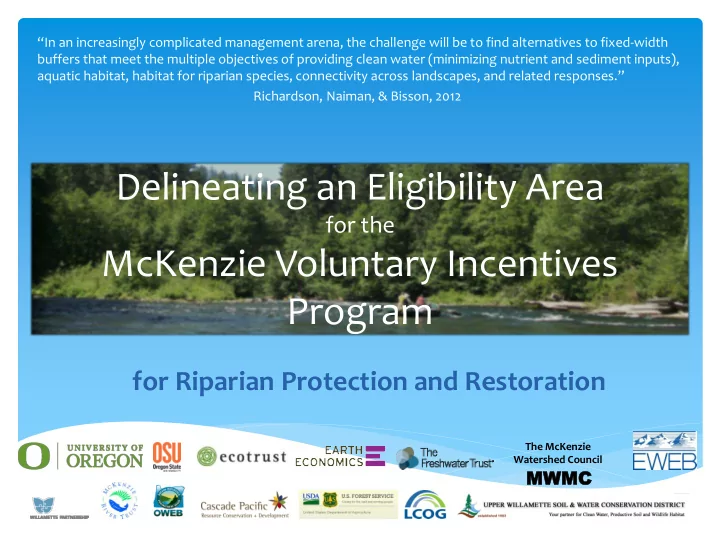

“In an increasingly complicated management arena, the challenge will be to find alternatives to fixed -width buffers that meet the multiple objectives of providing clean water (minimizing nutrient and sediment inputs), aquatic habitat, habitat for riparian species, connectivity across landscapes, and related responses.” Richardson, Naiman, & Bisson, 2012 Delineating an Eligibility Area for the McKenzie Voluntary Incentives Program for Riparian Protection and Restoration The McKenzie Watershed Council MWM MWMC
Goals for Delineating the Program Area 1. Credibly science-based: The Nature Conservancy’s Active River Area model 2. Easily explained to a lay audience 3. Repeatable in other watersheds 4. Useful for program analysis and evaluation.
Goals for Delineating the Program Area 1. Credibly science-based 2. Easily explained to a lay audience: The area of dynamic connection and interaction between the water and land through which it frequently or occasionally flows. 3. Repeatable in other watersheds 4. Useful for program analysis and evaluation.
Goals for Delineating the Program Area 1. Credibly science-based 2. Easily explained to a lay audience 3. Repeatable in other watersheds: The model depends primarily on nationally-available NHD and USGS DEM datasets. 4. Useful for program analysis and evaluation.
Goals for Delineating the Program Area 1. Credibly science-based 2. Easily explained to a lay audience 3. Repeatable in other watersheds 4. Useful for program analysis and evaluation: a) The model identifies a broad set of landscape elements and functions rather than focusing individual instream processes like sedimentation or vegetated buffer strips. b) The model produces a cost-surface, not a hard boundary, increasing its use.
TNC’s Active River Area Model Active River Area (ARA) Estimates the riparian area, not tied to flood extent specifically Uses nationally available NHD & USGS DEM data Relies on NHD Stream Order attribute Open code, rapid to deploy Well documented, using known ESRI tools
Conceptual Process Framework The watershed is divided into three longitudinal sections of • headwater • medium • and river stream segments and creates • Active river areas • wet-flat areas • and material contribution areas. These area are delineated using a slope-based cost surface.
How Cost is Calculated (ESRI documentation) The cost assigned to each cell represents the cost per unit distance for moving through the cell. The final value per cell is the cell size multiplied by the cost value. For example, if the cost raster has a cell size of 30, and a particular cell has a cost value of 10, the final cost of that cell is 300 units.
Model Calibration ARA cost-surface thresholds are set for Headwater Stream River areas in response to different landscape conditions. Resultant areas merged together to generate ARA. Other landscape types use similar calibration process against reference datasets. We focused on the riverine and stream sections for program implementation.
Model Results & Use ARA Functional Landscape Types VIP Program Boundary
Project Partners Eugene Water & Electric Board McKenzie Watershed Council (MWC) Upper Willamette Soil & Water Conservation District (SWCD) Cascade Pacific Resource Conservation and Development Lane Council of Governments McKenzie River Trust University of Oregon Oregon State University US Forest Service The Freshwater Trust Metropolitan Wastewater Management Commission (MWMC) Others
Recommend
More recommend